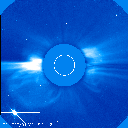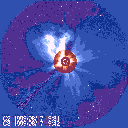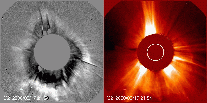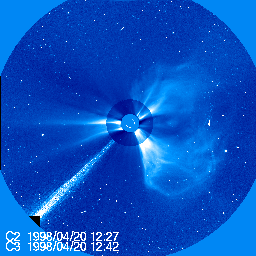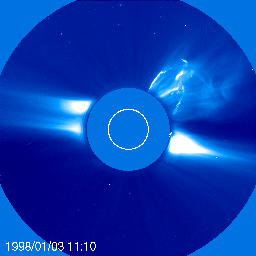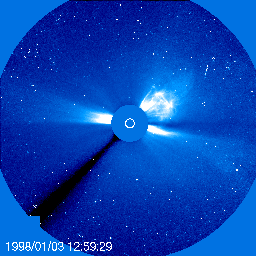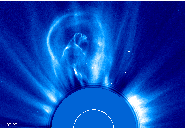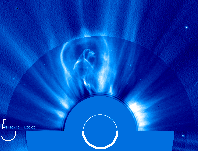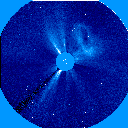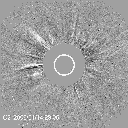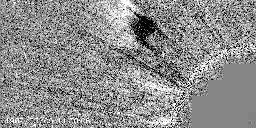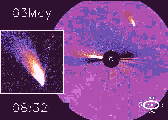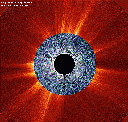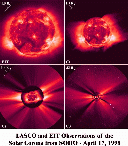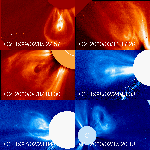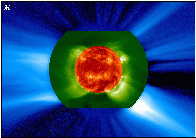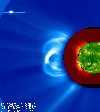Movies and Images of the Solar Corona from the LASCO coronagraph on SOHO
Authors:
K. Dere, R. Howard, P. Reiser1, N. Rich1, D. Socker, A. Vourlidas2, D. Wang1
Naval Research Laboratory, Code 7660, Washington DC USA 20375-5320
1 and Interferometrics, Inc., 2 and George Mason University
B. Podlipnik, B. Inhester, N. Srivastava, R. Schwenn Max Planck Institute for Aeronomy, Lindau, Germany
G. Simnett, Department of Physics and Space Research, University of Birmingham, Birmingham, UK
S. Koutchmy, Institut d'Astrophysique de Paris-CNRS, 75014 Paris, France

Note: Use a MPEG or JPG/GIF viewer to view the movies and images. Web browsers such as Internet Explorer or Netscape often reserve lots of colors for themselves and leave few for use by other applications. Also, the Windows Media Player can not display some of the larger movies and does a poor job of rendering many of the others.


The LASCO Instrument
The Large Angle Spectrometric COronagraph (LASCO) includes 3 coronagraphs C1, C2, and C3 with circular fields of view shown below. C1 is a reflective, internally-occulted coronagraph while C2 and C3 are externally occulted coronagraphs. A more detailed description of LASCO can be found in Brueckner et al., 1995, Solar Physics, 162, 357. LASCO and EIT provide SOHO with the capability of imaging the solar corona from its base through 30 solar radii.
- C1 1.1 to 3 solar radii
- C2 1.5 to 6 solar radii
- C3 3.7 to 30 solar radii
The goals of the LASCO investigation were to study the dynamics of the corona including regions as the polar holes and coronal streamers, the physics of coronal mass ejections (CMEs) and their geomagnetic effects, comets and dust in the solar system.
SOHO is a project of international cooperation between ESA and NASA. LASCO was built by an international consortium of four institutions in four different countries:
- Naval Research Laboratory, Washington, DC
- Max-Planck-Institute for Aeronomy, Lindau, Germany (see also LASCO C1 home page, in German)
- Department of Physics and Space Research, University of Birmingham, Birmingham, UK
- Laboratoire d'Astronomie Spatiale, Marseille, France

LASCO Instrument Photos
(External files -- Requires Java)
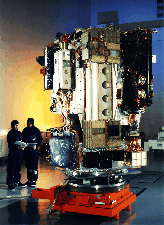
Annotated LASCO/SOHO Flight Module |
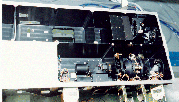
Annotated LASCO C2 (inside) |
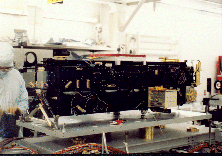
Annotated LASCO Instrument (side) |
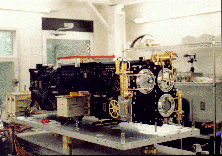
Annotated LASCO Instrument (front) |

A Cosmic Cornucopia: the solar corona, the Milky Way and a sun-grazing comet
the 1996 C3 Christmas movie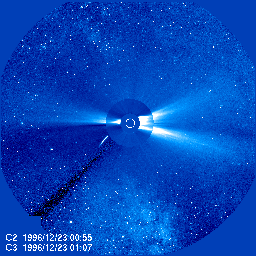
(MPEG 7.0 MB) |
A closer look: the 1996 C2 Christmas movie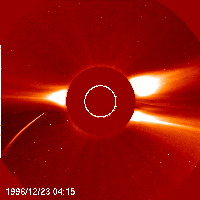
(MPEG 1.2 MB) |

Spectroscopy of the Solar Corona with LASCO C1
One of the innovations of of the LASCO experiment was to include a tuneable, narrow band Fabry-Perot filter in the C1 coronagraph. This allowed LASCO to obtain images in spectral lines such as Fe X (637 nm) and Fe XIV (530 nm). By scanning across the spectral line, detailed profile information can be obtained. From the line profiles, the flow patterns in the corona are determined. An example of the data from such an observing sequence is shown below. The top left panel shows movies of the total integrated intensity, the top right panel shows the line of sight velocity derived from the net doppler shift of the line profile, and the bottom left panel shows the line width which is the result of the thermal and the small-scale velocities in the corona.
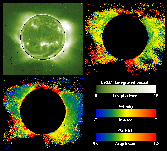

The corona over one rotation seen in LASCO C1 and C2
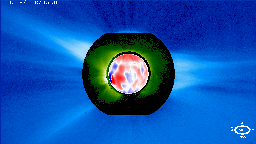
(MPEG 2.8 MB) On the disk, the photospheric magnetic field measurements from the Wilcox Solar Observatory are shown. In the lower corona, the images are the intensity of the Fe XIV line measuremed in C1 and, in the outer corona, the Thomson scattered white-light detected by C2. Observed between 1996 August 13 and September 8. |
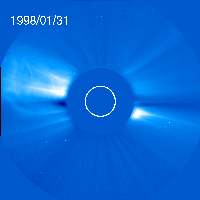
(MPEG 3.2 MB) The solar corona observed over 1 month between 1998 January 26 and February 26 observed with C2. The cadence is about 1 image per hour. |

Halo CMEs: CMEs directed toward the Earth
Halo CMEs were given their name because of their appearance which resembles a diffuse 'halo' around the Sun. The halo can encircle the entire corona or only a part of it. Halo CMEs were discovered with the NRL SOLWIND experiment (Howard et al., 1982, ApJ, 263, L101). The halo signature is that of a CME that originates on the solar disk and is directed toward LASCO which is near the Earth. Many halo CMEs do impact the Earth and cause geomagnetic storms (Brueckner et al., 1998, GRL, 25, 3019; Webb et al., 2000, JGR, 105, 7491; Cane et al., 2000, GRL, 27, 3591).
1997 April 7 |
1999 August 17 (2 partial halos) |
2000 February 17 |

Fast CMEs
Fast CMES produce shocks which accelerate high energy particles. Energetic particles are also produced low in the corona in association with solar flares. These particles then travel near the speed of light and can be detected near Earth well ahead of the CME itself. The LASCO CCDs serve as rather unsophisticated energetic particle detectors. Cosmic rays continually impact the CCDs and are always evident in the LASCO movies as scattered twinkles in individual CCD pixels. The intense flux of energetic particles in this event shows up as a `snow storm' in latter half of these LASCO movies
1997 November 6
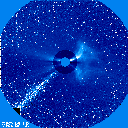
(Half Resolution MPEG 0.5 MB) |
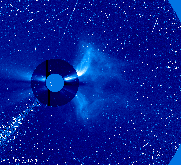
(Full Resolution MPEG 0.9 MB) |
1998 April 11 - 20: An interesting period:
Between April 10 and April 13, a comet enters the field of view from the left
(East) and passes around the Sun. On April 10-11, a smaller sun-grazing comet
approaches the Sun from the south, just to the right of the occulter pylon. The
period culminates in a fast CME associated with a high energy particle storm at
SOHO

CMEs associated with eruptive prominences
1998 January 3
LASCO C2 |
LASCO C3 |
1998 June 2 CME
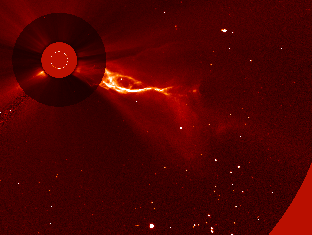
(EIT, C1 and C2 combined, MPEG 0.24 MB) |

(C1, MPEG 1.8 MB) |
1999 October 13
LASCO C2 |
LASCO C2 and C3 |

A flux-rope CME: 1997 October 19
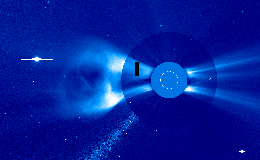
(MPEG 1.0 MB) |
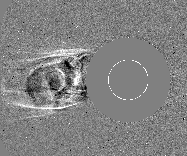
(Running Difference version, MPEG 6.7 MB) |
A smoke-ring CME: 2000 February 15 Movie

Coronal Inflows and Small-scale Mass Ejections
Coronal Inflows |
Small-scale mass ejections |

Comets Observed with LASCO

Comet Hyakutaki
A comet was also seen (here) in December 1996
Two comets were seen also seen (here) in April 1998

LASCO IMAGES

LASCO and Eclipse image(Click for a larger version 0.3 MB) S. Koutchmy et al. (Institut d'Astrophysique de Paris-CNRS) |
EIT and LASCO C1 and C2 |

A Collection of Flux Rope CMEs |
EIT/C1/C2/C3 |
LASCO C1 and C2

Click for a larger version (0.15 MB) |

Click for a larger but half size version (0.05 MB) |
EIT and LASCO C1 and C2 |
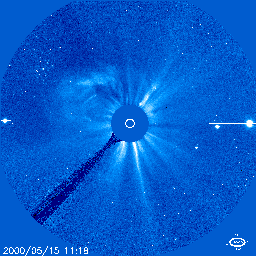
Annotated LASCO C3 Image of Planetary Alignment (Java) |

The participation of the Naval Research Laboratory in the LASCO/SOHO program is sponsored by NASA.
